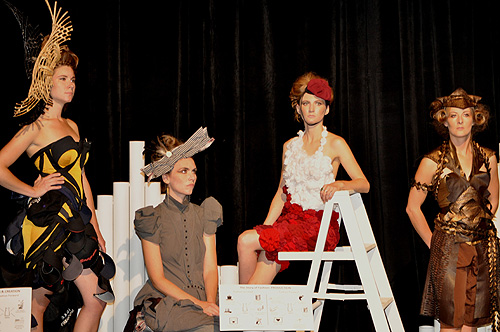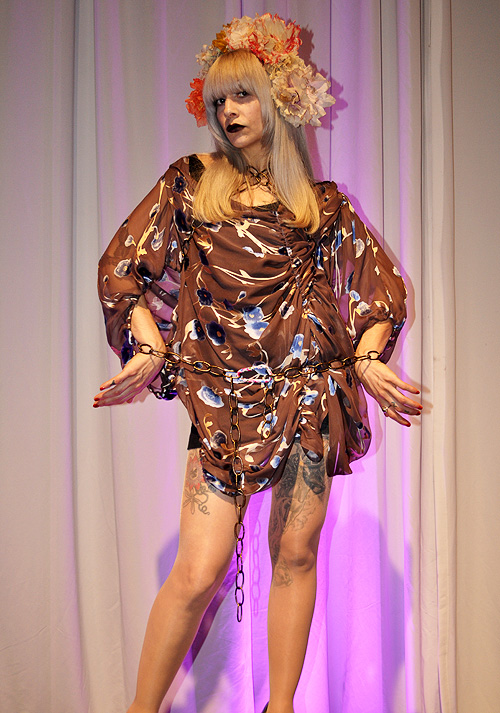 Portland Fashion Week kicked off Wednesday night with an Installation Show featuring local artists and designers. The show brands itself as “the world’s only comprehensively eco-conscious production of fashion week.”
Portland Fashion Week kicked off Wednesday night with an Installation Show featuring local artists and designers. The show brands itself as “the world’s only comprehensively eco-conscious production of fashion week.”
BY EMMA HALL
 |
Fashions made from recycled materials. L-R: “Take Me Out to the Ballgown” by Ruth Waddy, “Dress Shirt” by Jen LaMastra, “Runway Rerun” by Taylor Stevenson, “Armadagami” by Traci Price. // Photo by Shaun Strickland |
Although the Pearl District may seem like a more suitable venue, Portland Fashion Week is being held in a Vigor Industrial Shipyard warehouse on Swan Island. Show-goers must take a series of one-way streets on Swan Island and park amid cranes in the shipyard before making their way to Warehouse #10, where the show is held. The industrial atmosphere first makes it seem like you are attending some secret party (though Portland Fashion Week, now in its eighth year is far from secret anymore). It quickly becomes apparent that the choice of location perfectly fits with the show’s sleek, dark solar panel theme. Fashion Week has certainly come a long way from smaller shows such as the Portland City Hall appearance in 2006.
Although some of the exhibitions featured what you would expect to see at a fashion show (stone-faced models idly standing in silky, locally-designed clothes) some designers went with a more interactive approach. Rio Wrenn’s R.A.W. Textiles showcased rust-printed lingerie displayed in a mock boudoir setting- complete with strewn-about discarded undergarments and a tea-sipping, exercise-performing model.
One of the most interesting exhibits was a conceptual piece by Pacific Northwest College of Art + Oregon College of Art and Craft MFA candidate Laura Allcorn. Her “Human Pollination Project” aims to address honeybee colony collapse disorder. She showcased sterling silver hand pollination sets that allow people to take on the job of honeybees, with miniature magnifying wands, tweezers, finger scrapers, applicators meant to mimic bee’s bodies, and tiny containers for collecting anthers and pollen.
Fashion Week runs through Sunday, Oct. 10, but the main event will be Saturday’s show featuring Project Runway Season 7 winner Seth Aaron Henderson of Vancouver. Henderson came up with the idea to use solar panels for the runway in collaboration with SolarWorld, a German solar panel company that recently moved its United States headquarters to Hillsboro.
 |
Dawn Sharp’s models wore the Spring/Summer ’10 line and held signs saying “Winter is over – if you want it.” // Photo by Shaun Strickland |
Well-known for his black, sharp-edged designs, Henderson toured the SolarWorld factory this summer to draw inspiration for his collection. SolarWorld Public affairs manager Ben Santarris describes Henderson as a “solar enthusiast” who plans to use solar panels on his new home.
Although a solar panel company sponsoring a fashion event may at first seem mismatched, SolarWorld has a history of sponsoring other events that may not directly relate to solar energy – for example, they are also the Timbers jersey sponsors. “We like where [Portland Fashion Week] is going, and how they are trying to convince the fashion industry to move more towards sustainability,” Santarris said.
Traditionally, solar panels are black with white frames, giving a hatched appearance that some consumers feel sticks out and looks too obviously like, well, solar panels. SolarWorld is pioneering new black monocrystalline solar panels that they say “make a fashion statement on your home.” The black-on-black appearance, much akin to the seemingly requisite outfit of Fashion Week attendees, lends a sleeker look that consumers increasingly prefer, and which may even conform to more home owner’s association requirements.
Fashionable and environmentally progressive? How very Portland of you, fashion world.
Emma Hall is web editor for Oregon Business.


